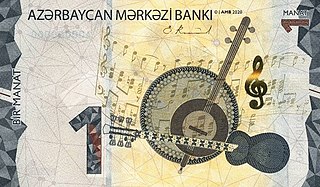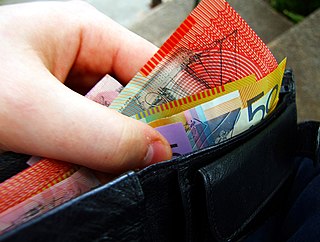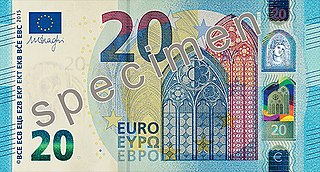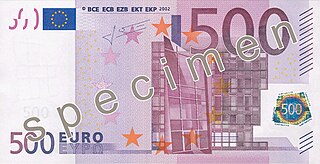Related Research Articles

The euro is the official currency of 20 of the 27 member states of the European Union. This group of states is officially known as the euro area or, commonly, the eurozone, and includes about 344 million citizens as of 2023. The euro is divided into 100 euro cents.

The pound sterling is the official currency of the United Kingdom, Jersey, Guernsey, the Isle of Man, British Antarctic Territory, South Georgia and the South Sandwich Islands, and Tristan da Cunha.

The Bank of Scotland plc is a commercial and clearing bank based in Scotland and is part of the Lloyds Banking Group. The bank was established by the Parliament of Scotland in 1695 to develop Scotland's trade with other countries, and aimed to create a stable banking system in the Kingdom of Scotland.

Clydesdale Bank is a trading name used by Clydesdale Bank plc for its retail banking operations in Scotland.

The convertible mark is the currency of Bosnia and Herzegovina. It is divided into 100 Pfenig or Fening (Пфениг/Фенинг) and locally abbreviated KM. While the currency and its subunits are uniform for both constituent polities of Bosnia and Herzegovina, namely the Federation of Bosnia and Herzegovina (FBiH) and Republika Srpska (RS), the designs of the KM 10, KM 20, KM 50, and KM 100 banknotes are differentiated for each polity.

The hryvnia or hryvnya has been the national currency of Ukraine since 2 September 1996. The hryvnia is divided into 100 kopiyok. It is named after a measure of weight used in Kievan Rus'.

The manat is the currency of Azerbaijan. It is subdivided into 100 gapiks.

The dinar is the currency of Bahrain. It is divided into 1000 fils (فلس). The Bahraini dinar is abbreviated د.ب (Arabic) or BD (Latin). It is usually represented with three decimal places denoting the fils.

Polymer banknotes are banknotes made from a synthetic polymer such as biaxially oriented polypropylene (BOPP). Such notes incorporate many security features not available in paper banknotes, including the use of metameric inks. Polymer banknotes last significantly longer than paper notes, causing a decrease in environmental impact and a reduced cost of production and replacement. Modern polymer banknotes were first developed by the Reserve Bank of Australia (RBA), Commonwealth Scientific and Industrial Research Organisation (CSIRO) and The University of Melbourne. They were first issued as currency in Australia during 1988 ; by 1996, the Australian dollar was switched completely to polymer banknotes. Romania was the first country in Europe to issue a plastic note in 1999 and became the third country after Australia and New Zealand to fully convert to polymer by 2003.
Banknotes of Scotland are the banknotes of the pound sterling that are issued by three Scottish retail banks and in circulation in Scotland. The issuing of banknotes by retail banks in Scotland is subject to the Banking Act 2009, which repealed all earlier legislation under which banknote issuance was regulated, and the Scottish and Northern Ireland Banknote Regulations 2009. Currently, three retail banks are allowed to print notes for circulation in Scotland: Bank of Scotland, Royal Bank of Scotland, and Clydesdale Bank.

Banknotes of the euro, the common currency of the eurozone, have been in circulation since the first series was issued in 2002. They are issued by the national central banks of the Eurosystem or the European Central Bank. The euro was established in 1999, but "for the first three years it was an invisible currency, used for accounting purposes only, e.g. in electronic payments". In 2002, notes and coins began to circulate. The euro rapidly took over from the former national currencies and slowly expanded around the European Union.

The five euro note (€5) is the lowest value euro banknote and has been used since the introduction of the euro in 2002. The note is used in the 25 countries which have it as their sole currency ; with a total population of about 343 million currently. In July 2023, there were approximately 2,159,000,000 five euro banknotes in circulation around the eurozone. It is the fifth most widely circulated denomination, accounting for 7.2% of the total banknotes. Estimates suggest that the average life of a five euro banknote is less than a year before it is replaced due to wear.

The ten euro note (€10) is the second-lowest value euro banknote and has been used since the introduction of the euro in 2002. The note is used in the 25 countries which have it as their sole currency ; with a population of about 343 million. In July 2023, there were approximately 3,033,000,000 ten euro banknotes in circulation around the eurozone. It is the fourth most widely circulated denomination, accounting for 10.2% of the total banknotes. Estimates suggest that the average life of a ten euro banknote is about 1.5 years before it is replaced due to wear.

The twenty euro note (€20) is the third-lowest value euro banknote and has been used since the introduction of the euro in 2002. The note is used by the 25 countries and a population of 343 million as their sole currency, with 23 legally adopting it. In July 2023, there were approximately 4,837,000,000 twenty euro banknotes in circulation around the eurozone. It is the second most widely circulated denomination, accounting for 16.3% of the total banknotes. Estimates suggest that the average life of a twenty euro banknote is about two years before it is replaced due to wear.

The fifty euro note (€50) is one of the middle value euro banknotes and has been used since the introduction of the euro in 2002. The note is used by some 343 million Europeans and in the 25 countries which have the euro as their sole currency. In July 2023, there were about 14,523,000,000 fifty euro banknotes in circulation in the eurozone. It is by far the most widely circulated denomination, accounting for almost half (49.0%) of the total banknotes. Estimates suggest that the average life of a fifty euro banknote is about four years before it is replaced due to wear.

The one hundred euro note (€100) is one of the higher value euro banknotes and has been used since the introduction of the euro in 2002. The note is used daily by some 343 million Europeans and in the 25 countries which have it as their sole currency. In July 2023, there were approximately 3,942,000,000 hundred euro banknotes in circulation in the eurozone. It is the third most widely circulated denomination, accounting for 13.3% of the total banknotes.

The two hundred euro note (€200) is the second highest value euro banknote and has been used since the introduction of the euro in 2002. The note is used in the 25 countries that have the euro as their sole currency ; with a population of about 343 million. In July 2023, there were about 849,000,000 €200 banknotes in circulation around the eurozone. It is the second least widely circulated denomination, accounting for 2.9% of the total banknotes.

The five-hundred-euro note (€500) is the highest-value euro banknote and was produced between the introduction of the euro in 2002 until 2019. Since 27 April 2019, the banknote has no longer been issued by central banks in the euro area, but continues to be legal tender and can be used as a means of payment. It is one of the highest-value circulating banknotes in the world, worth around 537 USD; 3,902 CNY; 79,165 JPY; 479 CHF, or 430 GBP as of September 2023. The note is used in the 25 countries which have the euro as their sole currency, with a population of about 343 million.

The Clydesdale Bank £5 note, also known informally as a fiver, is a sterling banknote. It is the smallest denomination of banknote issued by the Clydesdale Bank. The current polymer note, first issued in 2015, bears an image of engineer William Arrol on the obverse and an image of the Forth Bridge on the reverse. It is the first fully polymer banknote to go into circulation in the United Kingdom.
References
- ↑ "Archived copy" (PDF). Archived from the original (PDF) on 2008-04-09. Retrieved 2008-06-20.
{{cite web}}: CS1 maint: archived copy as title (link) - ↑ "BBC NEWS". news.bbc.co.uk. Retrieved 2021-09-16.